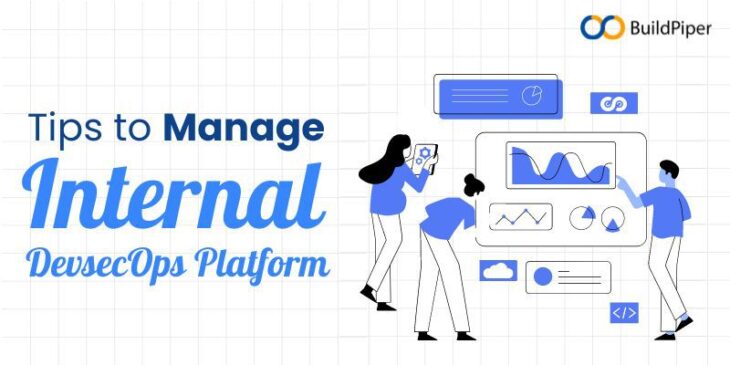
In the fast-paced world of software development, where agility and speed are paramount, incorporating security seamlessly into the development process is critical. DevSecOps, a methodology that integrates security practices into the DevOps pipeline, plays a key role in achieving this balance.
As organizations strive to fortify their defences against cyber threats, IDP adoption in enterprises has become a strategic imperative. In a scenario, managing your internal DevSecOps platform effectively is essential to ensure robust security measures without sacrificing the speed of development. In this blog, we’ll explore practical tips for managing your internal DevSecOps platform to foster a secure and agile development environment.
Benefits of Internal DevSecOps Platforms
Internal DevSecOps platforms offer a multifaceted approach to integrating security into the software development lifecycle. These platforms are designed to streamline and enhance security practices, fostering a collaborative and proactive environment. Let’s delve into the detailed benefits of adopting IDP best security practices,
- Proactive Security Integration
One of the primary benefits of internal DevSecOps platforms is the proactive integration of security into the entire development process. By embedding security practices from the outset, organizations can identify and address vulnerabilities early in the SDLC, minimizing the risk of security issues in production. - Reduced Time to Market
DevSecOps platforms automate security checks and integrate them into the continuous integration/continuous deployment (CI/CD) pipeline. This automation not only enhances security but also accelerates the delivery of software. Reducing manual intervention and delays associated with traditional security practices helps in enhancing Developer Productivity with IDP implementation. - Shift-Left Security Practices
DevSecOps encourages a “shift-left” approach to security, meaning that security considerations are addressed early in the development process. The adoption of IDP in enterprises facilitates this shift-left mentality by integrating security practices into the development pipeline. This allows teams to identify and remediate vulnerabilities during the coding phase. - Infrastructure as Code (IaC) Implementation
DevSecOps platforms often align with Infrastructure as Code (IaC) principles. Managing infrastructure configurations as code enables organizations to enforce security policies consistently across different environments. This standardized approach enhances security and improves the resilience of infrastructure.
Tips to Manage Internal DevSecOps Platforms
Discussed here are some valuable tips to manage your Internal DevSecOps platforms that can help DevOps teams in choosing the right IDP solution for their business.
Establish a Strong Foundation
Build a solid foundation by integrating security practices into the early stages of your development pipeline. This includes secure coding standards, automated code reviews and static code analysis tools. By catching security vulnerabilities early in the development lifecycle, you can save time and resources in the long run.
Automate Security Testing
Leverage automation to streamline security testing processes. Implement automated security testing tools, such as dynamic application security testing (DAST) and interactive application security testing (IAST), to identify and address vulnerabilities in real-time. Automation not only accelerates the testing process but also ensures a consistent and thorough examination of your codebase. Automation also helps in enhancing developer productivity with IDP management as it reduces manual intervention.
Continuous Monitoring
Adopt continuous monitoring practices to stay vigilant against potential threats. Implement tools that provide real-time visibility into your infrastructure and applications. Continuous monitoring allows you to detect and respond to security incidents promptly, reducing the impact of potential breaches.
Integrate Security into CI/CD Pipelines
Embed security checkpoints directly into your continuous integration/continuous deployment (CI/CD) pipelines. This ensures that security measures are an integral part of the deployment process, preventing insecure code from reaching production environments. Automated security gates can block or flag code that doesn’t meet security standards.
Implement Infrastructure as Code (IaC)
Embrace Infrastructure as Code to manage and provision your infrastructure securely and consistently. By treating infrastructure as code, you can apply security policies consistently across different environments, ensuring a standardized and secure deployment process.
Emphasize DevSecOps Culture
Cultivate a DevSecOps culture within your organization. This involves instilling a mindset where security is everyone’s responsibility. Encourage a proactive approach to security, where developers actively participate in identifying and addressing security issues throughout the development lifecycle.
Regular Security Audits
Conduct regular security audits to assess the effectiveness of your DevSecOps practices. Engage external security experts for penetration testing and vulnerability assessments to identify potential weaknesses in your system. Regular audits provide insights into areas for improvement and help enhance your overall security posture.
Final Wrap-up
Effectively managing an internal DevSecOps platform requires a holistic approach that integrates security into every aspect of the software development lifecycle. By implementing IDP best security practices, automating security testing and maintaining a proactive mindset, organizations can build and maintain a robust DevSecOps platform that delivers secure and high-quality software. As the threat landscape evolves, so must the strategies employed to safeguard software applications. That’s why, teams need to stay vigilant and adapt to emerging challenges and prioritize security to ensure the success of their DevSecOps initiatives.
BuildPiper: The Perfect Internal DevSecOps Platform for your team
If you want to take your software development to the next level by embracing the power of IDP, then choosing the right IDP solution is important. Look no further than BuildPiper, the ultimate platform designed to streamline security monitoring and Microservices management! BuildPiper is a comprehensive internal DevSecOps platform that empowers your development, operations and security teams to collaborate seamlessly, ensuring security is at the forefront of every step.
BuildPiper is a developer and engineering teams’ centric, fully-featured, end-to-end Kubernetes & Microservices Application Delivery Platform. It helps teams in seamless & secure monitoring and Microservices management. This Internal DevSecOps Platform offers integrated collaboration features, enabling team members to share insights, track progress and resolve security issues efficiently. With automated CI checks at each stage of pipeline implementation, the platform ensures secured CI/CD delivery. BuildPiper also integrates with popular development tools, such as Git, Jira and Jenkins, ensuring a smooth workflow without disruption.



